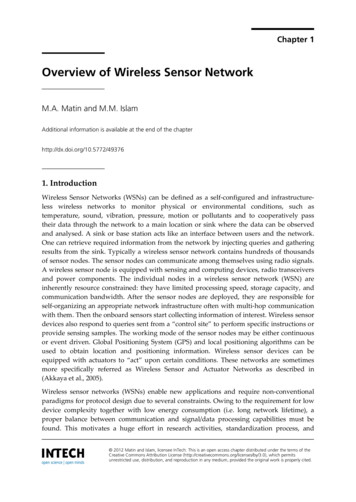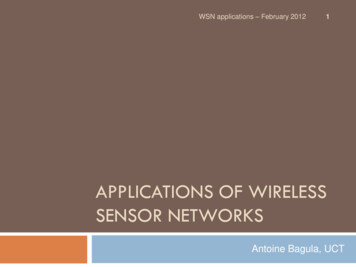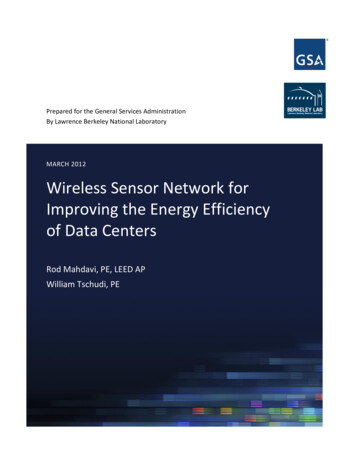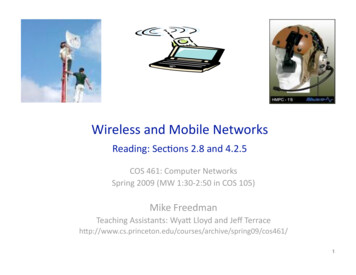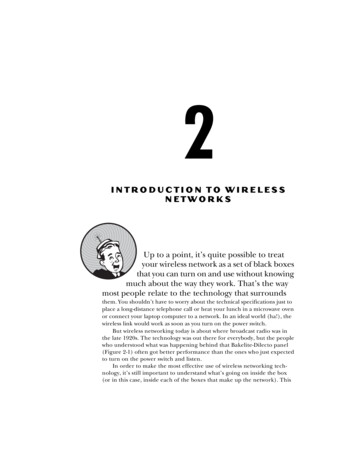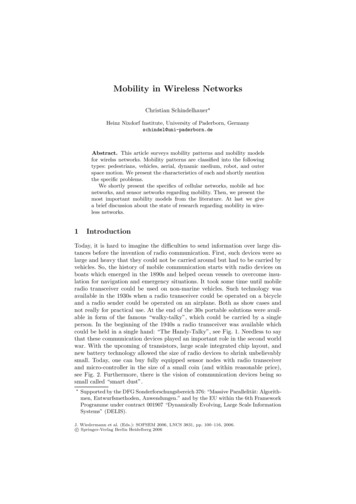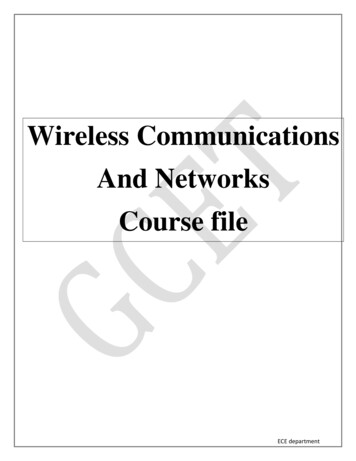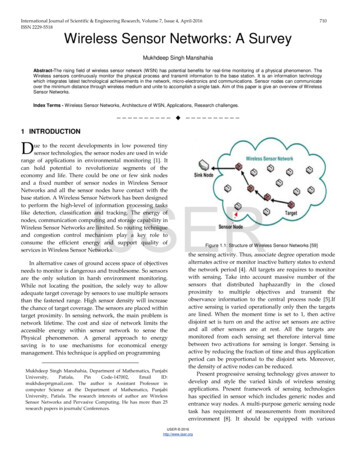
Transcription
International Journal of Scientific & Engineering Research, Volume 7, Issue 4, April-2016ISSN 2229-5518710Wireless Sensor Networks: A SurveyMukhdeep Singh ManshahiaAbstract-The rising field of wireless sensor network (WSN) has potential benefits for real-time monitoring of a physical phenomenon. TheWireless sensors continuously monitor the physical process and transmit information to the base station. It is an information technologywhich integrates latest technological achievements in the network, micro-electronics and communications. Sensor nodes can communicateover the minimum distance through wireless medium and unite to accomplish a single task. Aim of this paper is give an overview of WirelessSensor Networks.Index Terms - Wireless Sensor Networks, Architecture of WSN, Applications, Research challenges.—————————— ——————————1 INTRODUCTIONDue to the recent developments in low powered tinysensor technologies, the sensor nodes are used in widerange of applications in environmental monitoring [1]. Itcan hold potential to revolutionize segments of theeconomy and life. There could be one or few sink nodesand a fixed number of sensor nodes in Wireless SensorNetworks and all the sensor nodes have contact with thebase station. A Wireless Sensor Network has been designedto perform the high-level of information processing taskslike detection, classification and tracking. The energy ofnodes, communication computing and storage capability inWireless Sensor Networks are limited. So routing techniqueand congestion control mechanism play a key role toconsume the efficient energy and support quality ofservices in Wireless Sensor Networks.IJSERIn alternative cases of ground access space of objectivesneeds to monitor is dangerous and troublesome. So sensorsare the only solution in harsh environment monitoring.While not locating the position, the solely way to allowadequate target coverage by sensors to use multiple sensorsthan the fastened range. High sensor density will increasethe chance of target coverage. The sensors are placed withintarget proximity. In sensing network, the main problem isnetwork lifetime. The cost and size of network limits theaccessible energy within sensor network to sense thePhysical phenomenon. A general approach to energysaving is to use mechanisms for economical energymanagement. This technique is applied on programmingMukhdeep Singh Manshahia, Department of Mathematics, ukhdeep@gmail.com. The author is Assistant Professor incomputer Science at the Department of Mathematics, PunjabiUniversity, Patiala. The research interests of author are WirelessSensor Networks and Pervasive Computing. He has more than 25research papers in journals/ Conferences.Figure 1.1: Structure of Wireless Sensor Networks [59]the sensing activity. Thus, associate degree operation modealternates active or monitor inactive battery states to extendthe network period [4]. All targets are requires to monitorwith sensing. Take into account massive number of thesensors that distributed haphazardly in the closedproximity to multiple objectives and transmit theobservance information to the central process node [5].Ifactive sensing is varied operationally only then the targetsare lined. When the moment time is set to 1, then activedisjoint set is turn on and the active set sensors are activeand all other sensors are at rest. All the targets aremonitored from each sensing set therefore interval timebetween two activations for sensing is longer. Sensing isactive by reducing the fraction of time and thus applicationperiod can be proportional to the disjoint sets. Moreover,the density of active nodes can be reduced.Present progressive sensing technology gives answer todevelop and style the varied kinds of wireless sensingapplications. Present framework of sensing technologieshas specified in sensor which includes generic nodes andentrance way nodes. A multi-purpose generic sensing nodetask has requirement of measurements from monitoredenvironment [8]. It should be equipped with variousIJSER 2016http://www.ijser.org
International Journal of Scientific & Engineering Research, Volume 7, Issue 4, April-2016ISSN 2229-5518devices with physical attributes like as light, humidness,acceleration, temperature, atmospheric pressure, acoustics,force field, velocity etc. The bridge nodes collect the datafrom generic sensors or relay them to base station.Entranceway nodes contain higher process battery powerand transmission capability. A mixture of generic andentranceway nodes are generally developed to create aWSN [9]. Each sensing node has a personal system. Tosupport totally different variety of application softwaresystem on sensing system, the event of newest platformsand storage schemes is required. The communicationprotocols manage communication between the sensors andapplication. They permit the communication betweensensing nodes. The services are developed to improvenetwork potency and system performance [10]. Sensingnodes can arrange themselves very efficiently within thenetwork. Sensing nodes can be restricted in the processcapability, storage, power, communication protocols. So theefficient management services have been required to fulfilthe needs.The communication protocol has five protocol layers forthe packet switching: application layer, transport layer,data-link layer, network layer, or physical layer [11].Protocols at different layers address network dynamics andenergy potency. Functions like as storage, localization,synchronization, security, coverage, and knowledgeaggregation and compression can be expressed for sensingnetwork services [12]. In the protocol stack, different layersof protocols are implemented which can control the energyconsumption, system potency and end-to-end delay inorder to reduce the energy usage, so it is significant tooptimize the communication. The networking protocols arenot designed to achieve the basic needs, thus they are notsuitable for WSNs. [13]. However, new energy-efficientprotocols are projected for all layers of the protocol stack.These protocols can do cross-layer optimisation by supportinteractions across the protocol layers to harvest andminimize energy consumption [14].711different challenges and constraints depend upon theatmosphere. So wireless sensor network can be classified asunderwater WSN, terrestrial WSN, multi-media WSN,underground and mobile WSN [16].Terrestrial WSNs arecommonly includes lots of wireless sensing nodes settled inthe given space, either pre-planned or in ad hoc manner[17]. In unexpected placement, sensing nodes can bedropped from plane and notably placed into the geographicarea. In pre-planned placement, there are optimumposition, 2-D and 3-D placement models [57]. Inexceedingly terrestrial Wireless sensing networks, reliablecommunication in associate atmosphere is important tocommunicate back to base station [18]. Terrestrial sensingnodes having secondary battery for power supply becauseprimary source of battery can be prohibited and reversible.In wireless sensor networks, there are several approacheswhich can help to save energy. Some approaches are multihop fastened routing, network knowledge aggregation,eliminating knowledge redundancy, minimizing delays etc.Underground Wireless sensing networks involve the rangeof sensing nodes buried in caves to monitor undergroundconditions [19]. Additionally sink nodes can be placedwithin ground to relay knowledge from sensing nodes tobase station. These sensing nodes are expensive result ofacceptable instrument components that are opted to makesure the reliable communication via soil, water, rocks, andalternative mineral contents [20]. The atmosphere createschallenge in the wireless communication because of signallosses and high levels of the attenuation. Hence a typicalsensor node should have sensing, processing andcommunication capabilities for observation. A nodeconsists of a RF transceiver, microcontroller and power unitalong with ADC/DAC and a sensor.IJSER2 GENERATIONS AND ARCHITECTURE OFWSNWireless Sensor Networks evolved through manygenerations starting from simple sensors deployed in fieldsfor military applications to hazardous industrialapplications. Now, the sensor networks is mainly classifiedinto three fields based on the applications i.e. in WSN,energy consumption is major issue and in MANET’s,mobility of nodes consider as the major challenge forvarious mobile applications. Furthermore, in VANET’s,important challenge is to minimize the path length [15].Current Wireless sensing networks can beplacedunderwater and underground. Sensing network facesFigure 1.2: Architecture of a Sensor Node [61]Underwater Wireless sensing networks involve therange of vehicles and sensing nodes placed underwater[21]. These sensing nodes are expensive as comparison toterrestrial WSNs. The autonomous underwater vehicle hasbeen used for the exploration or collection of knowledgefrom sensing nodes. A typical underwater wirelessIJSER 2016http://www.ijser.org
International Journal of Scientific & Engineering Research, Volume 7, Issue 4, April-2016ISSN 2229-5518communications can be established through transmission ofthe acoustic waves. The challenges in underwater acousticcommunication are restricted information measure, longpropagation delay and signal deterioration.Multi-media Wireless sensing networks are enabled tosee and track events in the variety of multimedia systemlike as video, audio and imaging. Multi-media Wirelesssensing networks includes sensing nodes which haveinbuilt microphones and cameras. These sensing nodes canbe connected with other nodes in the network. In order toget coverage, these nodes are located in planned manner.The major challenges in WSN are high energyconsumption, quality of the service provisioning,compression techniques, processing and cross-layer style.Multi-media content like as video stream wants highinformation measure for the content to be delivered [22].High rate can cause high energy consumption.Transmission technique can support low energyconsumption and high information measure.Mobile Wireless sensing networks can involve thesensing nodes which can move and connect with thephysical atmosphere. Mobile nodes can sense, andcommunicate like static nodes. Mobile node has capabilityof preparation and reposition itself within network. Datagathered by the mobile node could also be transmitted tothe alternative mobile node. Mobile WSN faces variousissues like deployment, localization, navigation, selforganisation and coverage, management, maintenance andenergy etc [23].In direct communication routing protocols, each sensingelement node can communicates directly with Base Station.Base station can communicate with the end user eitherdirectly or through some existing network. The topology ofthe sensing element network changes frequently. Since thegap between the sensing element nodes and base station incase of direct communication is massive, but sensorsconsume energy quickly and become inoperative. In anotherapproach, knowledge is routed via intermediate nodes to thebase station and therefore saving node energy. A routingprotocol may be a protocol that specifies how routerscommunicate with one another, scattering information thatallows them to pick out routes between any two nodes on thenetwork, the selection of the route being done by routingalgorithms. Dynamic routing permits routing tables inrouters because the attainable routes can change. In case ofwireless sensing element networks, dynamic routing isusually used because nodes might modify their position anddie at any moment. So the benefits and drawbacks of wirelesssensing element networks will be summarized as follows: Network setups are complex. Ideal for the non-reachable places like across the ocean,mountains, rural areas or deep forests.IJSER3 CHARACTERISTICSA Wireless Sensor Network is fundamentally a network ofnodes that can jointly sense the physical environment. Themain characteristics of WSNs are flexibility, Maintainability,Scalability, self-monitoring, property of fault tolerance [24,25, 26]. Moreover, it provides quality of services and it canfulfil its task in harsh environment. Some problems can onlybe resolved by WSN like geographic scoping square measure.As compared with other networks, the services provided bywireless sensor network are real time and reliable.4 ROUTING IN WSNA sensing element node has restricted sensing andcomputation capacities, communication capability andpower. These nodes can communicate with one another forobtaining information either directly or through otherintermediate nodes. Therefore every node in an exceedinglysensing element network acts as a router within the network.7125 APPLICATIONS OF WSNWireless sensor networks (WSNs) are consisting of a largenumber of sensor nodes with limited energy resources.Major objective of WSN is to collect the informationaccurately and economically [28]. The improvement ofWSN was inspired by applications such as crimeinvestigation, target tracking, aircraft control, greenhousemonitoring [29, 30], marine environment monitoring [31,31, 32]. Wireless sensor network has wide range ofapplications like industrialapplications,medicalapplications, agriculture applications and many more [33,34]. Few of them are following [60]:Area observation: Area observation is a common applicationof WSNs [35]. In area observation, the WSN is deployed overa region to monitor the particular area and space [36].Health care observation [37, 38, 60]:The medicalapplications are often of two types: implanted and wearable.Wearable devices area unit used on the body surface of anindividual to monitor body position activity, and overallobservation of sick patients at different locations. Implantedsensors will gather information regarding a person's health,fitness, and energy expenditure.Environmental or Earth sensing [39]: WSNs are used tomonitor the environmental conditions like habitatmonitoring, animal life, breeding season, dense forest bydeploying sensor with help of aeroplane or helicopter.Air pollution observation [40]: Wireless sensing elementnetworks are deployed in many cities to observeIJSER 2016http://www.ijser.org
International Journal of Scientific & Engineering Research, Volume 7, Issue 4, April-2016ISSN 2229-5518concentration of dangerous gases in the environment of thecity. These are using wireless links instead of wiredinstallations that additionally provide mobility for examiningreadings in various areas.Forest fire detection: Sensing nodes are deployed in a forestto detect the fire and chances of fire [41, 42]. The firstdetection is important for victorious action of fire fighters totackle the fire and fire brigade will be ready on the basis offirst intimation of the sensors.Landslide detection: A landslide observation system makesuse of a wireless sensing element network to detect thechanges in numerous parameters that will occur before orthroughout a landslide. Through the gathered information itis easy to understand the prevalence of landslides long beforeit really happens [43, 60].Water quality observation: Water quality observationinvolves analysing water properties in dams, rivers, lake,oceans, underground water reserves [44, 45]. The utilizationof the many wireless distributed sensors allows thedevelopment of a lot of correct observation or map of thewater standing and quality.Natural disaster [46, 60]: Wireless sensing element networkscan efficiently act to stop the natural disasters like floods,Tsunami and earth quakes. Wireless nodes can be deployedin rivers wherever changes of the water levels ought to bemonitored in real time.Machine health observation [47]: Wireless sensing elementnetworks can be used for condition-based maintenance ofmachines as they provide vital price savings and can beplaced in harsh and troublesome locations where a wiredsystem is not possible like rotating machinery and unboundvehicles.Data logging [48]: Wireless sensing element networks arealso used for the collecting the environmental data. Theadvantage of WSNs over standard loggers is real time datatransmission.Structural Health observation [49, 50, 60]: In Structuralhealth observation, Wireless sensing element networks areoften accustomed to monitor the state of civil infrastructureand to connect the geo-physical processes in real time.713Dynamic topologies and harsh environmental conditions:In Physical environments, the topology and property of thenetwork could vary as a result of link and sensor-nodefailures. Moreover, sensors may additionally be affectedfrom high humidness levels, vibrations, dirt and mud, oralternative conditions that can degrade the performance[58].Quality-of-service needs: The big variety of applicationsenvisaged on WSNs can have completely different QoSrequirements and specifications. The QoS provided byWSNs refers to the accuracy between the informationreported to the sink node and the actual reality of the eventdetected by sensors.Data redundancy: Attributable to the high density withinthe network topology, device observations can beredundant. In addition, the character of the naturalphenomenon constitutes the temporal correlation betweenevery consecutive observation of the device node.Packet errors and variable-link capacity: Compared towired networks, Capability of every wireless link dependson the interference level and high bit error rates intransmission [58].Security: Security ought to be a necessary feature withinthe architecture of WSNs to make the communication safefrom external denial-of-service attacks and intrusion. WSNshave special characteristics that modify ways of securityattacks. Passive attacks are carried out by eavesdropping ontransmissions. Active attacks encompass modification,fabrication, and interruption that could embrace nodecapturing, routing attacks, or flooding.Integration with web and alternative networks: it isnecessary for the development of sensing network toprovide several services which give access to retrieve anyinformation at any time and thus it may be integrated withthe internet for information retrieval [53].IJSER6 CHALLENGESNETWORKSINWIRELESSSENSORThe major technical challenges for realization of WSNs areidentified as follows [51, 52, tation of WSNs square measure forced by threescarce resources:a) Limited energy.b) Limited memory.c) Limited computational capability.7 STORAGE MANAGEMENT IN WSNStorage management is an area of sensor network analysisthat starts to attract attention of researchers. For storagemanagement, data gathered by sensors is not transmitted tothe sink in limited time period. In such applications, theinformation should be keep, a minimum of briefly, amongthe network till later collected by the sink. Therefore, storagebecomes a primary resource, additionally to energy, thatdetermines time period and coverage of the network. Trendsthat inspire the necessity for storage management discussedthe appliance characteristics and numerous resourceconstraints that can influence the planning of storagemanagement techniques in sensor networks [54].Additionally, storage management break down into variouscomponents (1) system support for storage management; (2)cooperative storage; and (3) assortment. A storageIJSER 2016http://www.ijser.org
International Journal of Scientific & Engineering Research, Volume 7, Issue 4, April-2016ISSN 2229-5518management approach should be the balance of subsequentgoals: Minimize Size of stored information: Since sensorshave restricted storage offered to them, minimizing thedimensions of information that require to be keep endsup in improved coverage because the network willcontinue storing data for extended periods of time andbecomes additional economical if the information size issmall [55]. Minimize Energy Consumption: Most of the sensorsarea unit are battery-powered and so energy could be ascarce resource, so storage management must be energyefficient. Maximize information Retention or Coverage:Aggregated information is the primary goal of thenetwork. If storage is affected, information re-allocationshould be applied efficiently to ensure coverage for newdata. The management protocol ought to plan to retainrelevant information at an acceptable quality level.ACKNOWLEDGMENTAuthor is grateful to Punjabi University Patiala forproviding adequate library and internet facility.REFERENCES[1][2][3][4][5][6]8 RESEARCH CHALLENGES IN WSNSS. Savage, N. Cardwell, D. Wetherall, T. Anderson , “ TCPCongestion Control with a misbehaving receiver, ” ACMSIGCOMM Computer Communication Review, Vol. 29, Isssue 5,pp: 71-78, October 1999, .I.D. Chakeres, E.M. Belding-Royer, “PAC: Perceptive AdmissionControl for Mobile Wireless Networks,” Proceedings of FirstInternational Conference on Quality of Service in HeterogeneousWired/Wireless Networks, IEEE, 2004, pp: 18 – 26V. Rakocevic, “Congestion Control for Multimedia Applicationsin the Wireless Internet,” International Journal of CommunicationSystems, Volume 17 Issue 7, pp: 723 – 734, September 2004.F. Paganini, Z. Wang, J.C. Doyle,S.H. Low, “Congestion controlfor high performance, stability and fairness in general networks,”IEEE/ACM Transactions on Networking Los Angeles, Vol. 13, pp.43 – 56, March 2005.D. Katabi, M. Handley, “Precise feedback for congestion controlin the internet, ”MIT Technical Report, 2001.V. N. Padmanabhan, H.J. Wang, P.A. Choy, “ Supportingheterogeneity and congestion control in peer topeermulticasting,” Microsoft research, Online available at t.B. Hull, K. Jamieson and H. Balakrishnan, “ MitigatingCongestion in Wireless Sensor Networks,” Proceedings of the2nd international conference on Embedded networked sensorsystems , sensys 04, Baltimore, MD, Nov.3-5, 2004, pp: 134-147.C.Y. Wan, S.B. Eisenman and A.T. Campbell, “CODA: CongestionDetection and Avoidance in Sensor Networks,” Proceedings ofthe 1st international conference on Embedded networked sensorsystems, sensys 03, Los Angels, USA, Nov 5-7, 2003, pp: 266-279C.T. Ee and R. Bajcsy, “Congestion Control and Fairness for Manyto One Routing in Sensor Networks,” Proceedings of the 2ndinternational conference on Embedded networked sensor systems,sensys 04, Baltimore, MD, Nov.3-5, 2004, pp: 148-161.M. O. Rashid, M.M. Alam, M.A. Razzaque, C.S. Hong, “ ReliableEvent Detection and Congestion Avoidance in Wireless SensorNetworks,” R. Perrott et al. (Eds.): HPCC 2007, LNCS 4782,Springer-Verlag Berlin Heidelberg, 2007, pp. 521–532.R. Vedantham, R. Sivakumar, S.J. Park, “ Sink to SensorsCongestion Control,” Ad Hoc Networks 5, Vol. 5, Issue 4, pp 462485, May 2007.Chakraworthi.R and Gomathy. C, “ IFCCDC: A Fuzzy Controlbased congestion Detection and Control in Wireless SensorNetworks,” International Journal of computer Applications, Vol.47, No. 19, pp:12-17, June 2012.C. Sonmez, O.D. Incel, S. Isik, M. Y. Donmez, C. Ersoy, “ Fuzzybased congestion control for wireless multimedia sensornetworks,” EURASIP Journal on Wireless Communication andNetworking, Vol. 2014, No. 63, pp:1-17, 2014.U. Urathal, C. Chandrasekhar, “An Efficient fuzzy basedcongestion control technique for wireless sensor networks,”International Journal of Computer Application, Vol. 40, No.14,pp:47-55, Febrary 2012.Guobao Xu , Weiming Shen , Xianbin Wang, “Applications ofWireless Sensor Networks in Marine Environment Monitoring: ASurvey, ” Sensors, 2014, 14, pp: 16932-16954, 2014.IJSERWireless Sensor Network is a wide field of study. A lot ofresearchers proposed new techniques and compare themerits and demerits of their approaches with the previousexisting approaches. Energy efficiency, Congestion anddata loss in a wireless sensor network are the problems ofconcern in recent years. Congestion in any networkdegrades the quality of communication in the networkwhich in turn leads to the packet loss in network. Energyconservation in Wireless Sensor Network (WSN) is also apart of concern for several researchers in recent years.Many techniques which includes machine learningalgorithm have been introduced in recent years but stillthere is a gap for improvement in packet delivery andenergy consumption in WSN [56].[7][8][9][10][11]9 CONCLUSION[12]This survey presented an overview of Wireless SensorNetworks. The survey described the generations,architecture, Routing and storage management of wirelesssensor Networks. Applications areas and characteristics ofWSNs are also described in this paper. There are still manychallenges and constraints in the sensor networks includinglimited bandwidth and network lifetime of a node. Thepaper has also highlighted research challenges in WSN andidentifies the future research directions.714[13][14][15]IJSER 2016http://www.ijser.org
International Journal of Scientific & Engineering Research, Volume 7, Issue 4, April-2016715ISSN 2229-5518[16] H. Xu. H, X. Wang, C.K. Toh, "Comparative analysis of[29] Istvan Matijevics, “Advantages of wireless sensor networks ingreenhouse environment,” 7th International Symposium onscheduling algorithms in Ad Hoc Mobile Networking,"Intelligent Systems and Informatics, SISY '09 , IEEE , Subotica, 25Proceedings of Sixth international conference on parallel and26 Sept. 2009, pp: 155 – 159.distributed computing, Applications and Technologies, IEEE,Dec. 2005, pp: 639 - 643.[30] D.D.Chaudhary , S.P.Nayse , L.M.Waghmare, “Application of[17] G. Chandrashekar, S. S. Manvi, “Fuzzy Logic based CongestionWireless Sensor Networks for Greenhouse Parameter Control inPrecision Agriculture,” International Journal of Wireless & Mobilecontrol in Wireless Multimedia Sensor Networks,” InternationalNetworks (IJWMN) Vol. 3, No. 1, pp:140-149, February 2011.Journal of Latest Trends in Engineering and Technology, Vol. 4 ,[31] R.K. Yedavalli, R. K. Belapurkar, “Application of wireless sensorIssue 2, pp:216-221, July 2014.networks to aircraft control and health management systems, ”[18] L. Cheng, Z. Yong, X. Wei-xin, “ Traffic Regulation basedJournal of Control Theory and Applications, Vol. 9, No. 1, pp: 28Congestion Control Algorithm in Sensor Networks,” Journal of33, 2011.Information Hiding and Multimedia Signal Processing, Vol 5, No.[32] I.F. Akyildiz, T. Melodia, K.R. Chowdhury, “A survey on wireless2, pp: 187-198, April 2014.multimedia sensor networks,” Computer Networks, Vol. 51,[19] S. Meshram, R. V. Bobate, S. Chaturvedi, “ Congestion Control byIssue 4, pp: 921–960, 2007.Multiagent in Wireless Sensor Network, ” International Journal of[33] Manshahia, M.S., Dave, M. and Singh, S.B., “Bio InspiredSoftware and Web Sciences, Vol. 5, Issue 1, pp. 37-41, JuneCongestion Control Mechanism for Wireless Sensor Networks, ”August, 2013.[20] R.G. Aghaei, A.M. Rahman, M.A. Rahman, W. Gueaieb, “AntProceedingsof 2015 IEEE International Conference onColony-Based Many-to-One Sensory Data Routing in WirelessComputational Intelligence and Computing Research (ICCIC),Sensor Networks, ” Proceedings of IEEE/ACS InternationalMadurai, India , December 2015, pp:141-146 .Conference on Computer Systems and Applications, IEEE, Doha ,[34] I.F. Akyildiz , W. Su ,Y. Sankarasubramaniam ,E. Cayirci ,March 31- April 4 2008, pp: 1005 - 1010.“Wireless sensor networks: a survey,” Computer Networks, Vol.[21] K. Saleem, N. Fisal, M.A. Baharudin, A.A. Ahmed, S. Hafizah, S.38, Issue 4, 2002, pp: 393–422.[35] Yonghua Qu et al., “Crop Leaf Area Index Observations With aKamilah, “ Ant Colony inspired Self-Optimized Routing ProtocolWireless Sensor Network and Its Potential for Validating Remotebased on Cross Layer Architecture for Wireless SensorSensing Products,” IEEE Journal of Selected Topics in AppliedNetworks,” WSEAS transactions on communications,Vol 9, IssueEarth Observations and Remote Sensing, Vol. 7, No. 2, pp:43110, pp: 669-678, October 2010.444, February 2014.[22] A. Raha, M.K. Naskar, A. Paul, A. Chakraborty, A. Karmakar, “A[36] Tanya Vladimirova, C. P. Bridges, J. R. Paul, S. A. Malik and M.Genetic Algorithm Inspired Load Balancing Protocol forN. Sweeting, “ Space-based wireless sensor networks: DesignCongestion Control in Wireless Sensor Networks using Trustissues,” Aerospace Conference, IEEE, , Big Sky, MT, 6-13 MarchBased Routing Framework, ” I.J. Computer Network and2010, pp: 1 – 14.Information Security, Vol. 9, pp:9-20, 2013.[23] A. Verma, N. Mittal, “ Congestion Controlled WSN using Genetic[37] T.L. Alumona, V.E. Idigo, K.P. Nnoli, “Remote Monitoring ofAlgorithm with different Source and Sink Mobility Scenarios,”Patients Health using Wireless Sensor Networks (WSNs),”International Journal of Computer Applications, Vol. 101, No.13,International Journal of Electronics & Communication, Volume 2,pp: 8-15 Sept 2014.Issue 9, pp: 90-95, September 2014.[24] Sushruta Mishra, Hiren Thakkar, “ Features of WSN and Data[38] Nitya, Pushpam, Maninder Kaur, “An Advanced Wireless SensorAggregation techniques in WSN: A Survey,” International JournalNetwork for Health Monitoring,” International Journal ofof Engineering and Innovative Technology (IJEIT) Vol. 1, Issue 4,Advanced Research in Electrical, Electronics and Instrumentationpp:264-273, April 2012.Engineering, Vol. 2, Issue 2, pp: 882-887, February 2013.[25] Parul Bakaraniya , Sheetal Mehta, “Features of wsn and various[39] L. M. L. Oliveira, J. J. P. C. Rodrigues, “Wireless Sensor Networks:routing techniques for wsn: a survey,” International Journal ofa Survey on Environmental Monitoring,” Journal ofResearch in Engineering and Technology , Vol. 1, Issue 3, pp: 349Communications, Vol. 6, NO. 2, pp: 143-151, 2011.354, Nov-2012.[40] Y. R. V. Prasad, M. S. Baig , R. K. Mishra , P. Rajalakshmi, U. B.[26] Liu Yong-Min, Wu Shu-Ci , Nian Xiao-Hong, “ The ArchitectureDesai, S.N. Merchant, “ Real Time Wireless Air Pollutionand Characteristics of Wireless Sensor Network,” InternationalMonitoring System,” ICTACT Journal on CommunicationCon
Wireless Sensor Networks: A Survey Mukhdeep Singh Manshahia . Abstract-The rising field of wireless sensor network (WSN) has potential benefits for real-time monitoring of a physical phenomenon. The Wireless sensors continuously monitor the physical process and transmit informat

